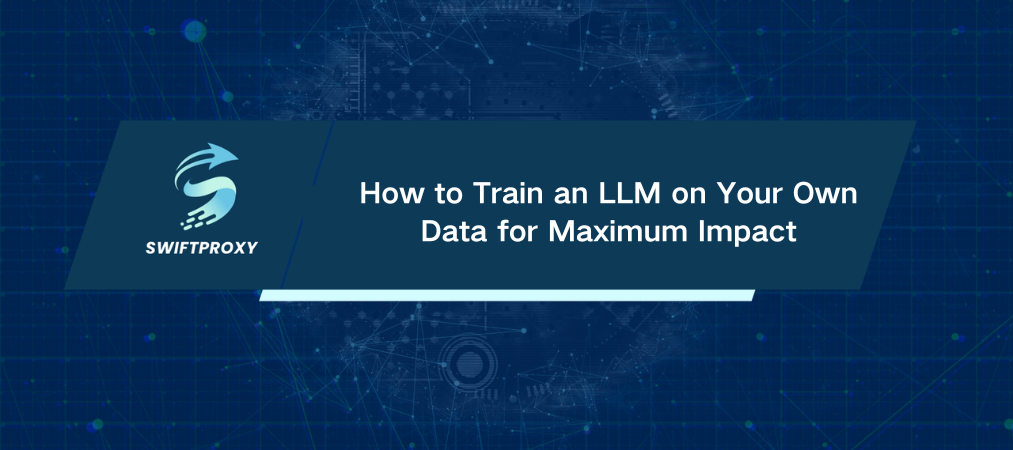How to Train an LLM on Your Own Data for Maximum Impact

Large Language Models (LLMs) are game-changers. They understand and generate text like never before. However, generic models don't speak your industry's language. They miss the nuances, jargon, and workflows that define your business.
That's why training—or fine-tuning—an LLM on your own data is a must. It's the difference between a good chatbot and an exceptional assistant tailored just for you. Ready? Let's dive into exactly how to do it, step by step.
What Does Training an LLM on Your Data Actually Mean
It all comes down to two key questions—how much you customize the model's internal brain, or weights, and which base model you start with.
Training from scratch means building that brain from the ground up, which demands serious compute power and time.
Fine-tuning, on the other hand, lets you adjust a pre-trained model using your own data, making it a faster and more cost-effective option.
As for model choices, off-the-shelf options are flexible but often too generic. Custom-trained models, however, are tailored to your niche—whether it's legal, medical, finance, or any other specialized field.
Why Training Your Own Model Matters
Off-the-shelf models are like one-size-fits-all suits—they rarely fit perfectly. Training your own model changes that.
It gives you pinpoint accuracy in your domain, reducing hallucinations and delivering more relevant answers. You also gain stronger data privacy by keeping everything in-house.
Faster performance is another benefit, as fine-tuned models typically require less compute. On top of that, you get tailored behavior, with outputs that align with your brand voice and meet regulatory requirements.
That said, there are some pitfalls to watch for—like limited data, licensing challenges, and hardware constraints. But don't worry, we'll cover solutions soon.
What to Prepare Before Getting Started
Quality Data
Formats like JSON, CSV, or plain text, properly anonymized and cleaned.
Solid Infrastructure
GPUs or TPUs (local or cloud), storage, and frameworks like Hugging Face or TensorFlow.
Skilled Team
Data scientists, ML engineers, and DevOps pros ready with a clear plan and metrics.
Step-By-Step LLM Training Workflow
1. Define Your Objectives
What's the mission? Chatbot? Document summarizer? Internal knowledge assistant? Lock down the use case—it shapes everything.
Pick metrics: accuracy, latency, clarity, relevance, or user satisfaction. Set targets. Be ruthless.
2. Collect and Prepare Data
Gather data from internal sources (support tickets, manuals) or external ones (websites, Wikipedia). Use tools like Swiftproxy API to automate collection.
Clean it by fixing formatting, removing duplicates, and standardizing terms. Garbage in means garbage out.
3. Choose Your Model
Small footprint? LLaMA 2–7B fits on modest machines. Need scale and speed? Cloud-hosted GPT-4.1 shines but costs more. Match model size to resources and goals.
4. Set Up Your Environment
Provision GPUs—local, cloud, or hybrid. Install Python, your ML framework (PyTorch or TensorFlow), Hugging Face Transformers, and experiment trackers like Weights & Biases or MLflow.
Version control is your friend—stay organized and reproducible.
5. Tokenize and Format Data
Break text into tokens using model-aligned tokenizers (e.g., GPT-2 tokenizer). Use Hugging Face libraries to speed this up. Clean inputs = better outputs.
6. Train or Fine-tune
Tune hyperparameters carefully: learning rate, batch size, epochs. Start small with a subset to catch errors early.
Train full scale once stable, checkpoint often, and track metrics live with W&B or MLflow.
7. Evaluate and Validate
Run standard metrics (F1, ROUGE, BLEU, perplexity) and real-world tests. Use unseen data, stress test with edge cases. Don't just prove it works—prove it's reliable.
8. Deploy and Monitor
Deploy with FastAPI, Flask, or Hugging Face's inference toolkit. Containerize with Docker for easy scaling.
Monitor latency, output quality, usage, and model drift. Set up feedback loops for continuous improvement.
Why Web Scraping and Proxies Matter
Your model is only as good as your data. Web scraping pulls real-world, domain-specific content to keep your dataset fresh and relevant.
But websites block bots. Here's where proxies come in. Residential proxies, like Swiftproxy's 70M+ IPs worldwide, rotate your identity to bypass blocks and geo-restrictions, so your data flow never stalls.
Want faster? Use automated tools like Swiftproxy API with pre-built templates to collect data from SERPs, eCommerce sites, social media—instantly.
Pro Tips and Best Practices
Lock down data security. Encrypt everything, manage credentials, audit access.
Fight bias proactively. Balance your dataset and run bias checks regularly.
Iterate endlessly. AI isn't "set and forget." Incorporate user feedback and schedule retraining.
Document thoroughly. Your future self and team will thank you. Clear docs = fewer headaches.
Stay compliant. Follow GDPR, HIPAA, or other regulations relevant to your data.
Common Pitfalls and How to Dodge Them
Low-quality data? Boost with synthetic samples and targeted augmentation.
Overfitting or underfitting? Use early stopping, regularization, and tune hyperparameters.
Performance drift? Monitor continuously and retrain as needed.
Cost creeping up? Run non-critical jobs on spot instances; optimize batch sizes and precision.
Technical debt? Version your data and configs meticulously. Track everything.
Final Thoughts
Training an LLM on your own data isn't just a technical challenge—it's a strategic advantage. You get sharper AI, full control, and a system that truly understands your business.
Use this guide as your roadmap—from planning to deployment. Layer in smart data collection with proxies and scraping tools, and keep your model fresh and future-ready.

















































